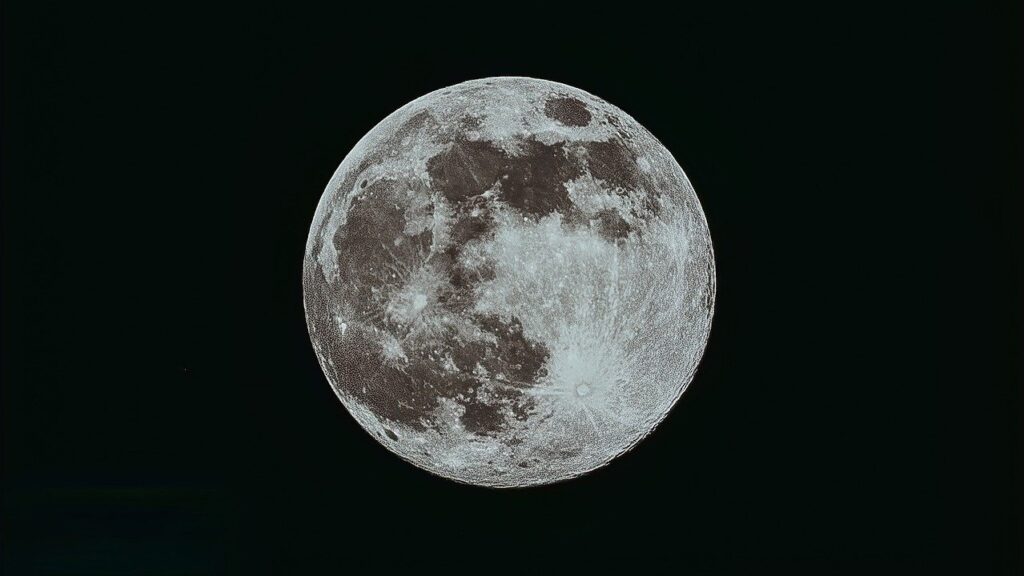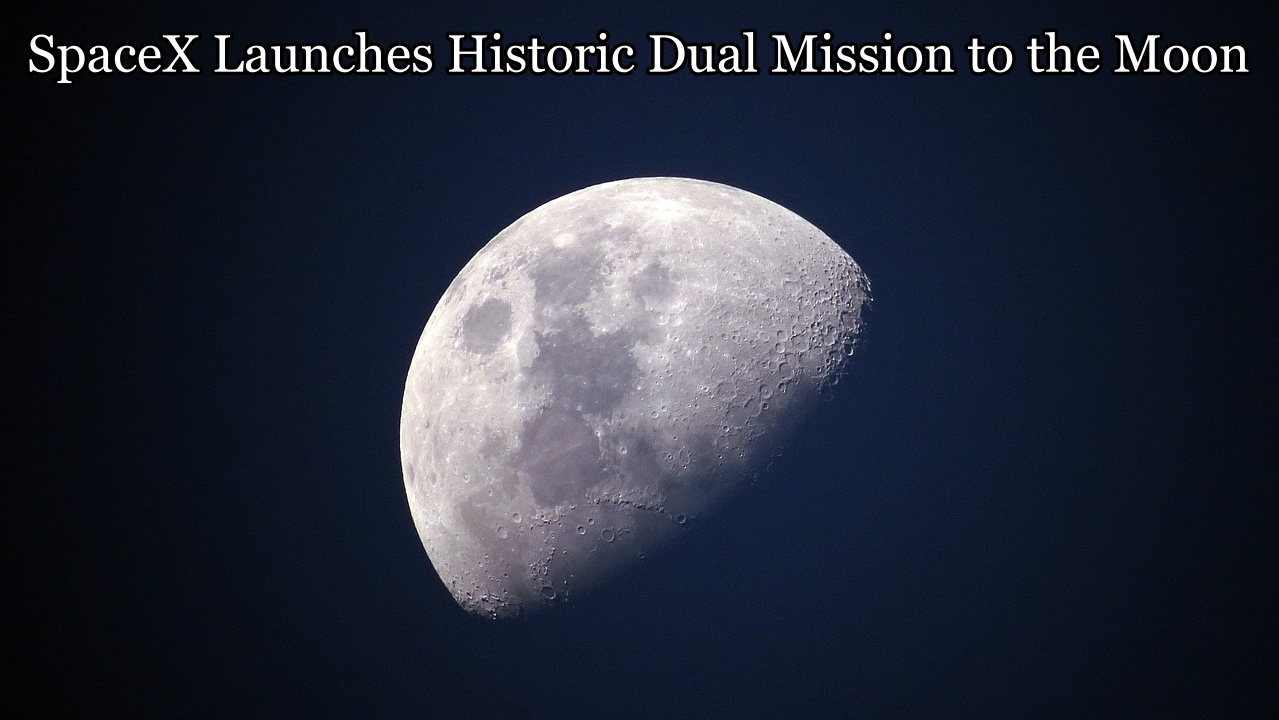SpaceX has made history once again with the launch of two groundbreaking lunar missions aboard a single Falcon 9 rocket. This ambitious mission marks a significant milestone in private aerospace, with both American and Japanese landers designed and built by private companies.
These landers are carrying scientific payloads that will play a pivotal role in NASA’s Artemis program and future human exploration of the Moon.
Two Landers, One Rocket: A Leap Towards Lunar Exploration
The Falcon 9 rocket that lifted off recently carried not one but two landers on their way to the Moon. The mission involves two distinct landers: the Blue Ghost Lander from the United States, built by Firefly Aerospace, and the Hakuto-R Lander from Japan, constructed by the private firm iace.
Both landers are carrying payloads crucial for scientific research, and their success will further bolster international collaborations under the Artemis Accords, a framework for lunar exploration involving NASA and its partner nations.
The American Lander: Blue Ghost by Firefly Aerospace
The American payload, Blue Ghost, is a lander designed by Firefly Aerospace, a private company based in Cedar Park, Texas. Firefly Aerospace has had a rocky start with its Alpha rocket, but Blue Ghost is a leap forward for the company. After three test flights between 2021 and 2023 (including two failed attempts), Blue Ghost is ready for its mission to the Moon, which will be a first for Firefly Aerospace.

Mission Overview:
Blue Ghost will first orbit Earth for 25 days, conducting system checks and collecting preliminary data using 10 scientific instruments provided by NASA. Once ready, it will embark on a four-day journey to the Moon. Upon arrival, it will spend another 16 days orbiting the Moon before executing a series of complex maneuvers to descend safely onto the surface.
Targeting the Mare Imbrium region—a volcanic area dotted with impact craters just north of the Sea of Tranquility—Blue Ghost will use advanced technology to select a suitable landing spot. The lander will perform a series of burns to reduce velocity and ensure a soft landing, ideally avoiding the pitfalls that have plagued past Moon missions.
Payloads and Scientific Research:
Blue Ghost will carry 10 scientific instruments to the Moon, including:
- Lunar Planet Vac: This instrument will “suck up” Moon dust (regolith) for analysis using compressed gas—essentially creating a “vacuum in a vacuum.”
- Stereo Cameras for Lunar Plume Studies: This camera system will study how dust behaves when disturbed, crucial for understanding the potential impact of dust on future Moon operations.
- Electrodynamic Dust Shield: A key piece of technology designed to repel moon dust, which can interfere with spacecraft operations and even damage equipment.
- Lunar Retro Reflector: A device that will help measure the precise distance between the Earth and the Moon.
- Lunar Drill: This drill will penetrate 2-3 meters into the Moon’s surface to measure thermal conductivity and changes in heat at various depths.
- Lunar Magnetometer: This instrument will study the magnetic field deep within the Moon’s mantle.
Over 14 Earth days, Blue Ghost will capture images of the lunar sunset, analyze how sunlight impacts the lunar surface, and conduct its final operations before its battery runs out. This is the start of a new era of private space exploration with NASA collaboration.
The Japanese Lander: Hakuto-R and Its Unique Payload
While Blue Ghost takes a direct route to the Moon, Japan’s Hakuto-R Lander is taking a longer, more methodical approach to lunar arrival. Launched by the Japanese private firm iace, Hakuto-R aims to make history with a series of scientific experiments, some of which are incredibly unique.
The first attempt to land a Hakuto-R vehicle on the Moon ended in failure in 2023 due to a computer guidance error. But this new mission, aptly named Resilience, is determined to succeed, making its journey with the goal of using as little fuel as possible by utilizing gravity assist flybys.
Mission Details:
Hakuto-R will deploy five scientific payloads, including:
- Water Electrolyzer Experiment: The first attempt to separate hydrogen and oxygen from water on the Moon using electrolysis. This could be a game-changer for future lunar habitation and resource utilization.
- Algae-based Food Production Module: A small experiment to explore the feasibility of growing food on the Moon, using algae to convert CO2 into oxygen—key for life support systems.
- Deep Space Radiation Probe: This will measure radiation levels as Hakuto-R travels from Earth to the Moon, providing valuable data for future space travelers.
- Mini Rover (Tenacious): This tiny, 5 kg rover will explore the lunar surface, collecting samples and taking high-definition images.
- Anime Memorabilia: A special payload from Japan’s cultural landscape—a commemorative alloy plate inspired by the Mobile Suit Gundam anime series. The plate is a nod to Japan’s pop culture and a symbol of its involvement in space exploration.
Hakuto-R is a testament to Japan’s innovative approach to space exploration, blending cutting-edge science with a touch of cultural flair.
The Future of Lunar Exploration
Both the Blue Ghost and Hakuto-R missions are key steps in advancing our understanding of the Moon. These missions will provide critical data on everything from lunar dust to potential water resources, paving the way for future missions under NASA’s Artemis program and other international collaborations.
The success of these missions will help shape the future of lunar exploration and establish the Moon as a crucial stepping stone for humanity’s ambitions in space. With private companies leading the charge, the next few years could see a flurry of innovative lunar missions, pushing the boundaries of what’s possible in space exploration.
Stay tuned for updates on these missions, and keep an eye out for more ambitious space missions in the months to come. February will bring another exciting attempt at the Moon with Intuitive Machines’ Nova-C lander, so the adventure is far from over.
FAQ
The Falcon 9 rocket’s launch of two lunar landers represents a major milestone in private space exploration, with both American and Japanese landers designed and built by private companies. This mission supports NASA’s Artemis program and future human exploration of the Moon.
The Blue Ghost Lander carries 10 scientific instruments, including a Lunar Planet Vac for analyzing Moon dust, stereo cameras for lunar plume studies, an electrodynamic dust shield, a lunar retro reflector, a lunar drill, and a lunar magnetometer.
The Hakuto-R Lander, developed by the Japanese private firm iace, aims to conduct a series of unique scientific experiments, such as the water electrolyzer experiment for hydrogen and oxygen production, algae-based food production, deep space radiation measurement, and deploying a mini rover.
Blue Ghost will orbit Earth for 25 days to conduct system checks, then embark on a four-day journey to the Moon, where it will spend 16 days orbiting before executing maneuvers for a soft landing on the Moon’s surface, specifically targeting the Mare Imbrium region.
A unique cultural payload aboard the Hakuto-R Lander is an anime memorabilia item: a commemorative alloy plate inspired by the Mobile Suit Gundam anime series, symbolizing Japan’s involvement in space exploration and celebrating its pop culture.
Read More:


2 thoughts on “SpaceX Launches Historic Dual Mission to the Moon: American and Japanese Landers Take Flight”